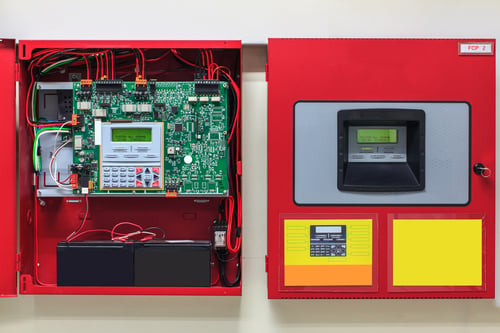 A fire pump usually refers to a pressure-increasing component of the water supply for fixed-place fire suppression systems such as fire sprinklers, standpipes, and foam systems. Fire pumps are also a critical component integrated into fire trucks and fire boats, and serve a similar purpose boosting water supplies for firefighting hose operations. Fire pumps are used to increase the pressure of water sourced from a municipal underground water supply piping network, or a static supply (e.g., tank, reservoir, lake). A fire pump is a centrifugal- or positive displacement- pump that has been tested and listed by a third-party testing and listing agency, such as UL or FM Global specifically for fire service use. The main standard that governs fire pump fixed-place installations in North America is the National Fire Protection Association’s NFPA 20 Standard for the Installation of Stationary Fire Pumps for Fire Protection.
A fire pump usually refers to a pressure-increasing component of the water supply for fixed-place fire suppression systems such as fire sprinklers, standpipes, and foam systems. Fire pumps are also a critical component integrated into fire trucks and fire boats, and serve a similar purpose boosting water supplies for firefighting hose operations. Fire pumps are used to increase the pressure of water sourced from a municipal underground water supply piping network, or a static supply (e.g., tank, reservoir, lake). A fire pump is a centrifugal- or positive displacement- pump that has been tested and listed by a third-party testing and listing agency, such as UL or FM Global specifically for fire service use. The main standard that governs fire pump fixed-place installations in North America is the National Fire Protection Association’s NFPA 20 Standard for the Installation of Stationary Fire Pumps for Fire Protection.
Fire pumps are powered most commonly by an electric motor or a diesel engine, or, occasionally a steam turbine. If the governing model building code requires backup power independent of the local electric power grid, a fire pump using an electric motor may utilize an emergency generator when connected via a listed transfer switch. Fire pumps installed on fire trucks and boats are powered by the engine of the vehicle/vessel.
Utilizing a control panel with pressure sensors, fire pumps automatically start when the pressure in the fire sprinkler system drops below a pre-designated threshold. Given the incompressibility of water, fire suppression system pressures drops significantly and quickly when one or more outlets open. Examples would be fused (opened) fire sprinklers, fire hose valves connected to a standpipe, or automatic control valves opened by release panels.
Fire pumps are utilized when determined by hydraulic calculations that the existing water supply cannot provide sufficient pressure to meet the hydraulic design requirements of the suppression system. This usually occurs if the building is very tall, such as in high-rise buildings (to overcome hydraulic head losses created from elevation differences), in systems that require a relatively high terminal pressure at the fire suppression outlets (to provide sufficient water droplet penetration of a fire plume), or in systems that require a large discharge of water (such as storage warehouses). Fire pumps are also needed if fire protection water supply is provided from a static source which provides little or no pressure. Some situations may be compounded by all of these factors, requiring large water supplies and powerful fire pumps.
Common types of fire pumps used for fire service include: horizontal split case, vertical split case, vertical inline, vertical turbine, and end suction.

Vertical Turbine Pump
A vertical turbine pump is the only type of pump allowed by NFPA 20, Standard for the Installation of Stationary Pumps for Fire Protection that can start with negative suction pressure or take water under a lift condition such as from a below grade source such as a river or subgrade tank. These pumps can be used with raw water sources such as ponds, lakes, and rivers. Vertical turbine pumps come in a wide range of capacities and pressures, and they can be used with diesel and electric drivers. 
In-Line Pump
In-line pumps are useful where space is limited. These can be driven by both a vertical or horizontal shaft (end suction type). Vertical shaft types, which are the most common, have the driver located directly above the pump. These are typically one of the less expensive units and take the least amount of space but, they are also one of the more expensive to repair. Pump maintenance and repair can be difficult because the motor must be lifted off and removed to gain access to the pump, unlike a split-case unit. With these pumps, the suction flange and discharge flange are on approximately the same plane. In-line pumps have a limited capacity of typically no more than 1,500 gpm (5,678 L/min), and they can only be used with an electric driver which limits their potential applications.
 Fire alarm control panel (FACP), fire alarm control unit (FACU), or fire panel, these appliances choreograph the activities of countless life-saving appliances to facilitate safe evacuation and swift emergency response during a fire. In this article, we’ll take a look at how a fire alarm control panel features in a complete fire alarm system, what’s required by the International Building Code (IBC) and the National Fire Protection Association (NFPA), and what these standards mean for choosing a fire panel.
Fire alarm control panel (FACP), fire alarm control unit (FACU), or fire panel, these appliances choreograph the activities of countless life-saving appliances to facilitate safe evacuation and swift emergency response during a fire. In this article, we’ll take a look at how a fire alarm control panel features in a complete fire alarm system, what’s required by the International Building Code (IBC) and the National Fire Protection Association (NFPA), and what these standards mean for choosing a fire panel.
- NFPA codes and standards, including the NFPA 1 Fire Code and hundreds of standards that relate to fire protection and fire extinguishing systems including sprinkler systems, smoke control systems, fire hoses, and tests relating to fire.
The NFPA Fire Code
While the NFPA does not have the power to police or enforce compliance of its Fire Code or standards, these codes and standards are used throughout the U.S. to determine compliance of the fire safety requirements of many regulations. For example, the NYC Building Code 2014 specifically requires compliance with NFPA standards for:
- Automatic sprinklers
- Standpipes
- Fire pumps
- Fire alarm systems
Also, where NFPA codes and standards use the word “shall” to indicate requirements, this generally implies reference to mandatory requirements by other codes or standards that have been adopted into law.
Apart from straightforward legal issues, the Fire Code, which is reviewed and amended every three years, provides for life safety by providing requirements that will reduce the probability of injury and death as a result of fire, explosions, or any other events that involve hazardous materials.
Further, the Code aims to provide an environment for occupants and members of the public who may be near to a building or facility that is “reasonably safe” from fire and similar emergencies. It also aims to protect emergency responders and fire fighters.
Elements defined in the 2018 edition of the NFPA 1 Fire Code, that are relevant to high rise fire alarm system design, include:
- Alarm which indicates the existence of a “condition” that calls for an immediate response – as in raise the alarm!
- Design specifications that embody building characteristics and other conditions that are controlled by the design team usually representing the client, architect, pertinent engineers, and possibly other designers.
- Detectorsthat have sensors which respond to certain physical stimuli including gas, heat, or smoke. More specifically, automatic fire detectors are designed to detect a “fire signature” that creates changes in the atmosphere and initiates action because of flames, gas, heat, smoke, and so on.
- Fire alarm signals that result from automatic or manual detection of fire alarm conditions.
- Fire alarm systems that consist of circuits and components that are arranged to monitor and reveal the status of various fire alarms and signal-initiating devices and, in this way, initiate an appropriate response.
- Fire hydrants used to supply hoses and fire department pumpers with water. These are valved connections on water supply systems that have one or more outlets.
- Fire protection systems that comprise any fire alarm device or system, or fire-extinguishing device or system, or a combination of these, that is designed and installed so that it will detect, control, or extinguish a fire or alert occupants of the building and/or the fire department so they know a fire has occurred.
- Fire retardants that are in a liquid, gas, or solid form and are used to inhibit combustion when used with combustible materials.
- High-rise building which indicates that the floor of a story that may be occupied is greater than 75 feet (23 meters) above the lowest level of the fire department vehicle access.
- Manual fire alarm boxes and pull stations that are used to initiate fire alarm signals.
These definitions are all in keeping with those listed in the NYC Building Code 2014 which is, of course, legally enforceable.






















